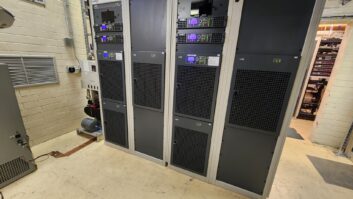Workbench offers tips by and for radio broadcast engineers.
Cumulus Youngstown Market Engineer Wes Boyd sends a note regarding our picture of the Eimac serial number in the Nov. 23 column. Keeping track of the serial numbers on high-power tubes can aid in warranty issues. But what does the code stand for? Wes received an e-mail from Jim Keen at WRMU, who forwarded a comment from engineer Joe Mauk.
Joe spoke to “Mr. Tube,” also known as Reid Brandon, at Eimac. Reid explained that the first letter in the serial number is a year code. Eimac started with the letter “A” for 1985, and continued through the alphabet. They didn’t use the letter I.
The other letters are a month code. Then there’s a numeric serial number. Being able to figure out the year the tube was manufactured should be helpful, especially in coding used or dud tubes.
Speaking of old tubes, some transmitters will provide excellent tube life, meaning years. Here’s a case where long tube life can bite you.
After more than seven years of tube life, a chief decides to buy a new final. Creeping parameters, especially rising screen voltage, mean the tube is nearing retirement.
The engineer gets the new tube and installs it; but now he gets zero output from the transmitter. Figuring the tube is a dud, he orders a replacement. Same problem. The old tube is put back into the transmitter, and things work fine.
These are brand-new tubes. What’s wrong? We’ll have the answer later in the column.
. . .
(click thumbnail)Fig. 1: An operating or common point impedance bridge gives a direct reading of impedance. Shown, a Delta Electronics OIB-3.
Let’s change horses here and take a look at some AM site inspection applications.
It goes without saying that the base current (for non-directional) or common point current (for directional) meter is measured. The direct power formula is then used to determine the operating power (Iant x Iant x Resistance = Direct Power). The “R” resistance is measured using an impedance bridge, similar to that in Fig. 1.
For a non-directional station, the resistance is measured at the tower base. In an AM directional, the resistance value is measured at the phasor common point. These values are listed on the station license. It makes sense to measure this impedance value periodically. Consulting engineers and many contract engineers have the equipment to make this measurement. Because the measurement directly determines the output power, it’s not a bad idea to have this checked every year or two.
For AM stations, the same “5 percent above, 10 percent below power” applies, but be careful. This is 5 percent above licensed power, not 5 percent above the antenna current indication.
Here’s what I mean. If the station measures 10A into 50 ohms, the direct power is 10 x 10 x 50 = 5,000 watts. (The direct power formula is power equals current squared, times resistance.) 5 percent above licensed power is 5,250 W. If you do the math, you will see that this is not 5 percent of the licensed 10 amps.
(click thumbnail)Fig. 2: Allow thermocouple meters time to warm up before reading them.
By the way, the current measurement should be made without modulation. The indication measured on older thermocouple meters, as seen in Fig. 2, will increase with modulation. Newer TCA toroid coupled ammeters, manufactured by Delta Electronics, will show carrier shift – deflecting downward.
To find out what the current maxima and minima are, you must calculate backward. 5,250W is the licensed power plus 5 percent. Divide this by 50 (the resistance) and take the square root of that number to get the current. The square root of 105 is 10.25A.
If you inadvertently take 5 percent of the licensed current (10 amps), you get an upper limit of 10.5A – this is 0.25A higher than the FCC authorizes. Making this mistake will cause you to be cited for overpower operation. The same problem occurs when you miscalculate for the lower power (10 percent low) value using the current instead of the power. This is a common error noted by inspectors; don’t get caught!
(click thumbnail)Fig. 3: Keep a record of phasor dial controls.
Once again, if you have old calculations at the transmitter site, especially that predate you, do the math and make sure they are right. When you’ve done this, tell the manager how you helped the station avoid a hefty fine. In some cases, with old impedance measurements that have changed, a station may be actually be operating below licensed power. Of course, the converse is also true, and must be corrected.
You should have a copy of the station license at the transmitter site. Include a listing of the pertinent licensed parameters so that it’s easy to check these numbers. Check the numbers periodically to ensure proper operation.
On an AM directional license, do not use the “theoretical” values for this purpose. These values were used by the consultant to design the directional array. Use the actual values for base current, phase and loop ratios, as these are the actual measured values when the proof was conducted.
Do the measured values differ from the actual licensed values? Don’t ignore this; report the findings to your chief engineer or consultant. Again, parameters at variance can lead to a fine.
A few other documents that should be at the site include a current copy of the tower registration information, STL or RPU licenses, and a current copy of the antenna or common point resistance sweep, plot and measurement.
As you become more familiar with your site, look over the license, and if any of the items differ from your inspection, find out why. Whatever you do, don’t adjust the phasor controls unless directly supervised by your chief or consultant.
At my transmitter workshops I tell a story of an overzealous jock. While straightening the transmitter room, he turned all the phasor cranks so they lined up perfectly. It sure looked nice, but it took days to get the pattern back.
(click thumbnail)Fig. 4: Check for illuminated overload lights.
The crank set-screws slipped, so when a crank was turned one full revolution, the coil or variable capacitor only turned half way or a third. It was impossible to tell where the phasor had been set prior to the jock’s alignment. It cost the station a lot of money and time to get the array back in tune.
Check the transmitter for any illuminated overload lights, as shown in Fig. 4. Identify them on the maintenance log or contracting workorder, reset the overload and see that the overload doesn’t return. Check all overload lights and make sure none are burned out. Usually there is a “lamp test” switch for this purpose.
. . .
So, any idea what’s wrong with those new tubes mentioned earlier?
Turns out there are differences in the process of the new 4CX3500A that have changed the input capacitance. The manufacturer re-did the ceramic to make it less likely to crack. However, the change caused the tuning to be very different.
In this particular case, the course output tuning line had to change 1/4 inch. Add to that, the solid-state IPA was folding back. The high voltage has to be cycled or power removed from the IPA to get the unit out of fold back.
After the tuning was readjusted, the transmitter ran fine. Let’s hope for another seven years of tube life. Thanks to Rick Levy of Broadcast Signal Lab for sharing this experience.
















